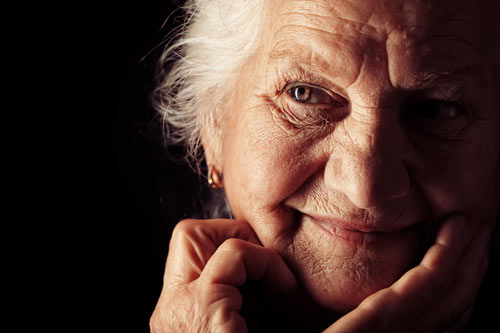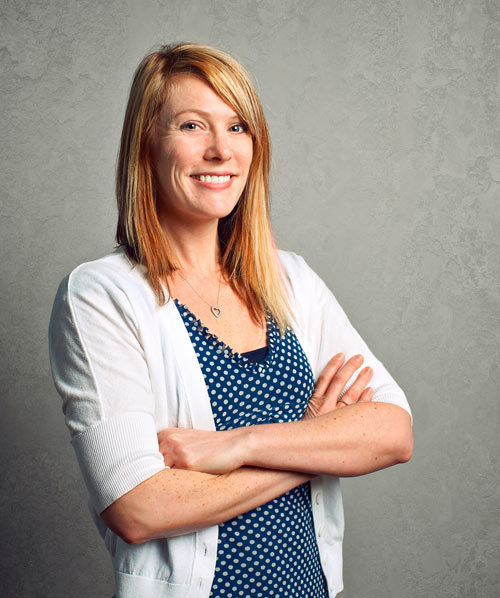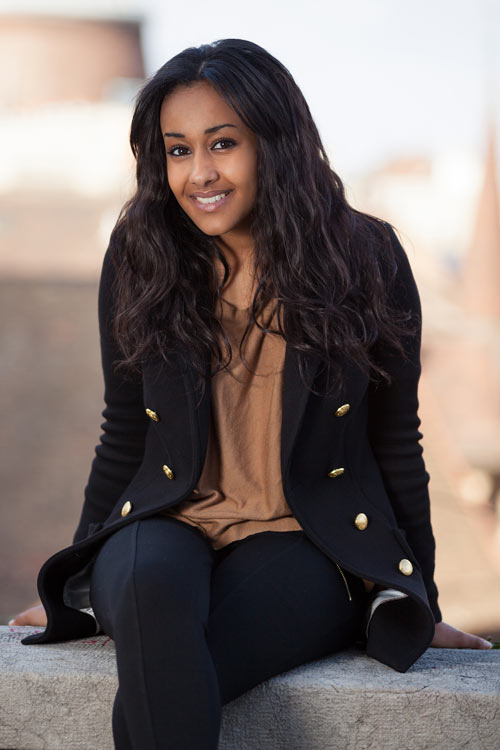
Women earned suffrage when the 19th Amendment was ratified in 1920. Title VII of the Civil Rights Act gave them a tool to chip away at the glass ceiling in 1964. We’ve heard of Katharine Hepburn, Simone de Beauvoir and Malala Yousafzai, but these milestones and characters fall flat read in textbooks. So we talked to local women spanning the generations of the 20th century and asked them to provide insight into their own journeys through prejudice and speculate about the challenges girls will face in the future.
Louise Newman is an associate professor of U.S. women’s history at the University of Florida. She’s also a Baby Boomer. The towering, well-stocked bookcases in her office hint at her expertise, but it’s her experience with women’s studies that makes her insight so valuable.
“Every generation is diverse; there’s a huge variety in experiences based on class, race and location,” Newman says, prefacing our discussion about generalized challenges for each generation. Her disclaimer highlights the Strauss-Howe Generational Theory, introduced by William Strauss and Neil Howe in their 1991 best seller Generations. Their theory kick started the trend of identifying shared beliefs and behaviors of each generation, as they came of age during the same period.
Although variables affect the experiences of each woman, members of the same age groups recall leaping or stumbling over many of the same hurdles. And although some of those obstacles have been surmounted, others have survived the ages as new ones develop.

The Silent Generation, 1925-1942, And Baby Boomers, 1943-1964. I wasn’t sure what to expect walking into a meeting for the GFWC Greater Ocala Woman’s Club, but a warm reception and invaluable discussion is what I found. I traversed the room, polling the women at random about the challenges of coming of age in their generation. Though the word itself was never uttered, prejudice was a common experience. Professor Newman gave me a little background.
“These women were expected to marry early. If they went to college, it was often as a precursor to marriage. People made fun of them, saying they were getting their MRS degrees,” she explains. “When Betty Freidan’s Feminine Mystique was published in 1963, some of these women would have reinvented themselves and had other lives after marriage and children, returning to school in their 50s as a result of the early feminist movement.” They would later become activists and make strides toward social change.
As we began our chat, Carol Robertson, 69, first described coming of age in simpler days.
“It was the age of rock ‘n’ roll, bobby sockers and going down to The Peppermint Lounge to learn the twist,” she recalls. It was also the age of the glass ceiling.
“Most girls either became teachers or nurses,” Carol says. “There were no astronomers, no doctors—that was it.” She herself studied English in college in order to become a teacher. Another member recalled dreaming of being a doctor but was told to try nursing instead. Susan Reynolds, 66, remembers her mother-in-law leading a life she may not have envisioned for herself in upstate New York, simply because she had no alternative, adding that she herself wasn’t educated until her 30s because it was considered a waste.
“My mother-in-law married and settled, had a family and worked on a farm. The more I got to know her, the more I thought that wouldn’t have been her choice. I don’t think she would have chosen it given today’s options.”
Ginger Price, 65, tried to take full advantage of every opportunity and still found herself chosen last. At the time of her retirement, she served as the program director for the Nationwide Healthy Information Network, but it took what she calls “drastic action” to get there.
“I was working at President Kennedy’s internship, and I qualified just like the boys, but they just wanted to tell me I printed nicely,” Ginger says, her tone conveying her distaste for being patronized. “The men were chosen for training while I sat back and worked, usually harder than they did.” Her workplace challenges did not end as an intern.
“There weren’t many places to promote women at the time, but a lot has changed in our lifetime. Eventually, I made it to an equal playing field with the men, or equal enough for me.”
Judy Stesney, 73, seems vivacious and outspoken during our chat. As a computer programmer, she worked at the heart of a male-dominated field but found herself keeping quiet about the unfairness she experienced there.
“I just adjusted, but I know many women felt aggressive about it,” she recalls. “It was clear that men made more than women, and you didn’t have a snowball’s chance in Hell if you were up for a promotion against a bunch of men. I did my job and got raises, but big promotions?” She shakes her head and waves her hand, miming the dismissal she received at the time. Then, she noted one advantage modern women now have, as well as one major disadvantage. “You have knowledge today, and it’s right at your fingertips. The biggest thing you have to face is competition—everyone is educated.”
Lastly, one member highlighted the taboo nature of divorce and said she felt pressure to stay with an abusive husband, even from her family, in order to avoid the scandal of separation. For the generation following hers, divorce became more acceptable, but it didn’t get any easier.

Generation X, 1965-1980. “Women from the late ‘50s on have access to birth control, so they think of themselves as having control over motherhood. They can time their births and have ambitions of succeeding equally in the professional world. It probably took them 10 to 20 years to realize that though the old barriers are gone, there are new ones now,” said Newman of Gen X.
Ashley Lightbody, 35, is president of Junior League of Ocala and has seen these changes embodied in her members.
“Ten years ago in Junior League, 85 percent of our women didn’t work. Maybe women are more educated now, but the spectrum has totally changed. Only 10 percent don’t work,” she explains.
“Our members have full-time jobs, and some of them are even the breadwinners.” Lightbody recently became her own breadwinner as well, which inspired her to empower other women.
“I’m recently divorced, and I was a housewife,” she says. “My biggest challenge was reentering the workforce. I’m studying to be a financial advisor to seek out women in transition who need help with their finances. We sometimes find ourselves in a situation like being a housewife when we have all this money, then don’t know what to do with it and leave it up to the men. I know there are a lot of women who don’t know what’s in the checking account, let alone how to access it.”
Though earning potential has been higher for men historically, Lightbody is happy to see more ladies joining the boys club in fields like finance, medicine and law.
“We’re just as ambitious as men, but we have to find the balance between family and work.” This is a sentiment echoed by Jennifer Hatchet, 36, also a member of Ocala Junior League.
Hatchet earned her master’s in sports management and holds the title of director of membership at the Country Club of Ocala. In her spare time, she does bookkeeping for her husband’s family business.
“I think for women of my generation, the biggest challenge is that we want to do everything because we have been empowered,” says Hatchet, citing her parents’ encouragement.
“My parents definitely empowered me and told me I could achieve anything I wanted to. I feel fortunate because I know my mother didn’t feel that way. She went to school to be a nurse because I don’t think she felt she could be a doctor. I also don’t think every woman in my generation was told the same thing.”
More important to Jennifer than her job is her family: husband Tony and daughters Holland and Keeghan, ages 6 and 4.
“I want to work and have a career, and I want to be a mother, an involved mom who volunteers in the classroom and makes the homemade Pinterest cupcakes.” Her biggest challenge is one straining many women in her age bracket: trying to give 100 percent at work and 100 percent to the family.

Generation Y, 1981-2000. When I asked Professor Newman what she thought millennials’ biggest issue will be she had plenty of theories to consider.
“Finding well-paying jobs in a volatile economy will be a challenge,” she begins. “The indebtedness one has to go into to get professional training is only going up. There are economic challenges of establishing oneself as a person—moving out, getting married. Those were the markers of adulthood from the ‘50s to the ‘80s. Will they continue to be the markers? We can’t yet say.”
Many millennial women feel that, thanks to the ladies of generations past, they have more opportunities in the workplace. This means their focus has shifted to other social issues, like gender, according to women’s studies major Joanna Bomfim, 20.
“I think there’s going to be a gender revolution that will slowly give us better relationships with our bodies and understandings of advertisements. Once we understand our relationships to these things, popular culture will have to take a step back.”
According to women’s studies major and millennial woman Gaby Larios, 19, this plugged-in generation needs more guidance on the use of social media as they tackle problems old and new.
“Cyber bullying didn’t exist for our parents, but it’s a real issue now,” she says, citing other issues like sexting. Beyond giving bullies another portal for torment, the Internet creates a permanent holding pen for indiscretions in the forms of racy photos, text conversations and more. Parents of the future will likely curate a safer online experience, but that doesn’t mean today’s women can’t wish for better guidelines.
Larios is also concerned about society’s difficulty addressing sexual harassment.
“I feel like no one teaches what to do when you’re sexually harassed. Coming forward yourself or addressing it with someone else can be really difficult,” she says. She noted the tendency to shame women for their clothing and wishes more mothers could’ve prepared their daughters for an unfriendly, stigmatized world, even for victims.
Professor Newman recalled a similar experience as a teen.
“I remember my parents saying ‘you can’t leave the house like that, you’ll be a target,’ and I remember thinking ‘that’s not my problem.’ There is an ongoing problem of blaming the victim to protect vulnerable women because we have a society that still preys on them.” The result, she says, is that millennials’ children may be even more strictly safeguarded than their parents.
“They’ve been sheltered more than my generation was, and their most pressing concern may be child safety,” she explains. “Women raised in the ‘50s and ‘60s expected to be harassed—boys did it in school yards, husbands did it to wives—but they didn’t expect to be abducted. There’s more supervision of young girls than there used to be. There was no fear children would be exposed to adults through the Internet and targeted; that is a post-‘90s phenomenon. These are concerns that impinge upon young women coming of age now.”
The National Eating Disorder Association reports eating disorder occurrences have been steadily increasing since 1930. Currently, 1 percent of women suffer from anorexia nervosa, 2 percent battle bulimia nervosa and up to 5 percent engage in binge eating. An unknown number of girls are victims of subclinical disorders, characterized by the same habits and obsessions but not extreme enough for diagnosis. Millennial woman Logan Redmond, 22, said that’s probably because body confidence can be hard for today’s young women to cultivate.
“I wish I knew how to be comfortable with my body and reject the media image of beauty,” she explains. “I grew up with friends who were much smaller. It wasn’t until I read something about Marilyn Monroe being a size 10 and a huge icon that I said ‘OK, I’m beautiful, too.” It happened in films of the ‘20s and ‘30s. It was sprawled across pages in Playboy in the ‘50s. It survived into music videos in the ‘80s. Today, our advertisements are rife with it.
“Every generation of women has had to face sexual objectification in some form of media,” says Newman. “It’s an ongoing challenge. Bulimia and anorexia were in epidemic proportions by the ‘90s. It’s a young woman’s problem in every generation.” She hopes young women will take heart knowing comfort in their skin will come with age, and there are many new public attempts “to accept different standards of beauty about weight, race and acceptable forms of self-presentation.”
Though the definitions of beauty and femininity are expanding, defining them in any way is still coercive, says Newman.
“Can a girl just be herself? That will remain a question for years to come.”

Generation Z, 2001-Present. A study by The Cassandra Report found that 43 percent of 7 to 13 year olds feel school violence and shootings will define their generation even more than social media, which many experts still believe will have a major impact on members of this group.
When asked what she fears her daughters will face, Jennifer Hatchet said she thinks they’ll deal with more social issues than previous generations.
“Bullying has become such an awful part of growing up, and it changes as we get older. Now we have cyberbullying. I wonder how that will evolve further with technology and even become part of the workforce.”
Kids now are building résumés from day one.
“It’s so different now because children need to be challenged, so they do chess and music lessons, but parents have no time for that. The obligations are much greater.
“We hope our hardships get easier,” adds Newman, but of course, some things never change. “Juggling parental responsibilities, workplace prejudice, I don’t think those will go away.”
If history does in fact repeat itself, America’s upcoming generation of women may still struggle against some of the same old constructs. However, there is hope that the women before them have blazed enough trails to prevent their challenges from reoccurring.
“I pray there won’t be a glass ceiling by the time they enter the workforce. They may not know those boundaries ever existed,” says Hatchet.
All In The Family. Sue Spuhler, 84, is a first-generation American. She lives in Homosassa today but emigrated from Norway in the ‘30s. She and her husband, Gene, have a daughter, Janet Johnson, 58. Janet has two daughters, Amy Roberts, 41, and Helena Kresge, 32. Helena’s daughter Jillian is 11. These generations of women have learned to shirk gender roles and lead independent lives while helping others. It started with Sue.
She faced challenges as an immigrant, like learning English, and is still involved in international outreach. Her civic-minded efforts have been passed down to the rest of the ladies, too.
“I had Girl Scouts, and I taught them to be alert, independent women, and I wanted them to know they make a difference,” says Sue. Her daughter and granddaughters echoed her sentiments, citing their work toward senior rights, children’s rights and women’s rights through women’s clubs and more. Janet tried to instill these values in her children, and they’ve been a key lesson in the family ever since. Janet also appreciates how her mother’s struggle was different from her own.
“In my mother’s generation, a man was able to earn enough money to support his family. The job of the wife was to keep the house clean, prepare the meals and take care of the children. There was a big swing into needing two paychecks to run a household in my generation, so now you’re working a 40-hour work week, too.” Helena knows this is true from her time as a single mom.
“It’s difficult having to support a household on one salary. I had to leave my position and move across the country because I had no one to watch my daughter. Not many jobs allow for taking care of a child, too.” Amy can relate to the single struggle.
“What I’ve had to deal with as a woman is being single a good amount of my adult life—you have to be able to fix water heaters. That’s not something my grandmother’s generation had to worry about because they knew they’d have a husband around,” she explains. “Brother learned to cook, and I learned household repairs. We didn’t have gender roles growing up in our family—everyone had to do part of the work.”
What do her elders fear for Jillian? Sue worries about modern attitudes toward education.
“One difficulty will be equating what she wants to learn to what the needs will be. Students don’t know what they need to study. Education is not just in a book; it’s in wanting to learn. They’ve got to stress goals instead of money. Accomplish something that wouldn’t happen if you weren’t there.”
“My fear for my daughter’s generation is crime,” says Helena. “There is a constant rise in sexual assault and people getting people’s information. I try to teach her to be aware of her surroundings and fight back. Maybe my daughter will be able to help someone someday,” says Helena.
Jillian is well aware of these hurdles, and she’s already planning to go to college, maybe to become a lawyer. She’s as socially conscious as her role models and well spoken enough to do exactly that.
“If you see someone and you can tell they need help, you help them. If you were down, you would want someone to prop you back up and give you support, too,” Jillian says of her favorite lesson she learned from her mother. Independence and good work ethic came next.
“I want to teach my children the values my great grandmother taught all of us and teach them that success only comes before work in the dictionary. I have a game plan; I don’t want to be that person who needs help from everyone.”
With a strong woman like Sue at the helm, this family made a home in a new country and continues to make the world their own when they don’t like what they see.
“Do not be afraid of making a decision; be afraid of not making a decision,” says Sue. “Leave the world better than you found it.”






